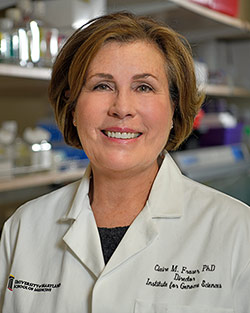July 16, 2021 | Deborah Kotz

Free online tool helps researchers easily utilize complex data from sophisticated genetic studies
Researchers at the University of Maryland School of Medicine (UMSOM) have launched a new online tool that could more quickly advance medical discoveries to reverse progressive hearing loss. The tool enables easy access to genetic and other molecular data from hundreds of technical research studies involving hearing function and the ear. The research portal called gene Expression Analysis Resource (gEAR) was unveiled in a study last month in Nature Methods. It is operated by a group of physician-scientists at the UMSOM Institute for Genome Sciences (IGS) in collaboration with their colleagues at other institutions.
The portal allows researchers to rapidly access data and provides easily interpreted visualizations of datasets. Scientists can also input their own data and compare it to other datasets to help determine the significance of their new finding.
 “This tool will save scientists a significant amount of time,” said study corresponding author Ronna Hertzano, MD, PhD, Associate Professor of Otorhinolaryngology-Head & Neck Surgery at UMSOM and founder of the gEAR. “Instead of relying only on identifying mutations in genes for hearing loss, researchers can easily identify which cells express any gene in the ear, and how this expression changes, for example, as a result of noise exposure or in processes of regeneration in other species.”
“This tool will save scientists a significant amount of time,” said study corresponding author Ronna Hertzano, MD, PhD, Associate Professor of Otorhinolaryngology-Head & Neck Surgery at UMSOM and founder of the gEAR. “Instead of relying only on identifying mutations in genes for hearing loss, researchers can easily identify which cells express any gene in the ear, and how this expression changes, for example, as a result of noise exposure or in processes of regeneration in other species.”
Dr. Hertzano and her team recently added data from the BRAIN initiative to a specialized domain of the gEAR portal to provide access to those performing neuroscience studies to better understand brain function and neurodegenerative diseases like Alzheimer’s. The portal is free and available to any researcher seeking access.
Users of the portal can do a variety of applications depending on their needs. They can access the dataset uploader and add their dataset into gEAR to view their data in a private setting. This enables them to see their findings in the context of other public data before posting their results online or submitting their paper for publication. Once a manuscript is published, a permalink can be included in the manuscript which links readers directly to a curated view of that dataset.
“The gEAR portal currently includes over 800 datasets, which we carefully reviewed before inputting,” said Dr. Hertzano. “We currently have more than 1,200 registered users and over 80 citations in research studies. We are expecting a large increase now that our methods paper is published.” She and her colleagues did a soft launch of the portal a few years earlier and publicized its existence via discussions with colleagues and user workshops at scientific meetings.
The Hearing Restoration Project, a non-profit research consortium funded by the Hearing Health Foundation, provided initial support of gEAR in an effort to better understand the mystery of hair cell regeneration – why hair cells in the ear regenerate in certain animals but not in humans. Our hair cells do not naturally regenerate when they die off due to aging, excess noise, or exposure to certain potent medications like chemotherapy drugs for cancer. For this reason, hearing loss is usually permanent and cannot be reversed. The consortium uses genomic analyses to compare molecular processes in species that do not regenerate hair cells. "The gEAR team closely interacts with the consortium researchers who also serve as our focus group, providing priceless feedback and suggestions,” Dr. Hertzano said.
Understanding how the expression of certain genes plays a role in hair cell regeneration – and how enzymes and other proteins mediate that process – could lead to new treatments to reverse hearing loss by triggering a regeneration of these cells.
 “By enabling rapid access to enormous datasets, the gEAR portal can serve as a valuable hub for community building around common research areas,” said Claire M. Fraser, PhD, the Dean’s Endowed Professor of Medicine, Microbiology and Immunology, and Director of IGS. “Having access to data in large repositories is not enough. What’s essential is that gEAR curates and organizes the data into an accessible format so it can be used to address important scientific questions.”
“By enabling rapid access to enormous datasets, the gEAR portal can serve as a valuable hub for community building around common research areas,” said Claire M. Fraser, PhD, the Dean’s Endowed Professor of Medicine, Microbiology and Immunology, and Director of IGS. “Having access to data in large repositories is not enough. What’s essential is that gEAR curates and organizes the data into an accessible format so it can be used to address important scientific questions.”
Study lead author Joshua Orvis, Lead Bioinformatics Software Engineer at IGS and study co-author Yang Song, PhD, Bioinformatics Analyst II at IGS, were instrumental in the development of gEAR. Researchers from the University of Maryland, College Park, National Institute on Deafness and Other Communication Disorders, University of Iowa, Johns Hopkins University School of Medicine, and Bar-Ilan University in Israel also contributed to this study.
“The gEAR portal is an outstanding example of the value of close collaboration of clinicians, biologists, and engineers to bridge the gap in technology and make the critically important 'omic' data generated across the world immediately accessible to biologists in a meaningful format,” said E. Albert Reece, MD, PhD, MBA, Executive Vice President for Medical Affairs, UM Baltimore, and the John Z. and Akiko K. Bowers Distinguished Professor, and Dean, University of Maryland School of Medicine.
The gEAR portal’s development has been funded by the National Institute on Deafness and Other Communication Disorders (NIDCD) and National Institute of Mental Health (NIMH), part of the National Institutes of Health (NIH), and the Hearing Restoration Project (HRP), part of the Hearing Health Foundation (HHF).
About the University of Maryland School of Medicine
Now in its third century, the University of Maryland School of Medicine was chartered in 1807 as the first public medical school in the United States. It continues today as one of the fastest growing, top-tier biomedical research enterprises in the world -- with 46 academic departments, centers, institutes, and programs, and a faculty of more than 3,000 physicians, scientists, and allied health professionals, including members of the National Academy of Medicine and the National Academy of Sciences, and a distinguished two-time winner of the Albert E. Lasker Award in Medical Research. With an operating budget of more than $1.2 billion, the School of Medicine works closely in partnership with the University of Maryland Medical Center and Medical System to provide research-intensive, academic and clinically based care for nearly 2 million patients each year. The School of Medicine has nearly $600 million in extramural funding, with most of its academic departments highly ranked among all medical schools in the nation in research funding. As one of the seven professional schools that make up the University of Maryland, Baltimore campus, the School of Medicine has a total population of nearly 9,000 faculty and staff, including 2,500 students, trainees, residents, and fellows. The combined School of Medicine and Medical System (“University of Maryland Medicine”) has an annual budget of over $6 billion and an economic impact of nearly $20 billion on the state and local community. The School of Medicine, which ranks as the 8th highest among public medical schools in research productivity (according to the Association of American Medical Colleges profile) is an innovator in translational medicine, with 606 active patents and 52 start-up companies. In the latest U.S. News & World Report ranking of the Best Medical Schools, published in 2021, the UM School of Medicine is ranked #9 among the 92 public medical schools in the U.S., and in the top 15 percent (#27) of all 192 public and private U.S. medical schools. The School of Medicine works locally, nationally, and globally, with research and treatment facilities in 36 countries around the world. Visit medschool.umaryland.edu
Contact
Deborah Kotz
410-706-4255
dkotz@som.umaryland.edu
Related stories

Wednesday, September 29, 2021
UM School of Medicine Researchers Work to Understand Hearing Loss from Noise Damage through Gene Expression Changes
A growing number of people suffer from hearing loss due to exposure to loud noises from heavy machinery, concerts, or explosions. As a result, scientists have been working to understand the mechanism behind how this damage to hearing actually occurs.

Friday, April 28, 2017
Expert Unravels Disease That Destroyed the Hearing of World-Famous Painter Francisco Goya
Francisco Goya is the most important Spanish artist of the late 18th and early 19th century. He was famed for his sensitive portraits, and many historians argue that he was the first truly modern painter.

Thursday, April 20, 2017
University of Maryland School of Medicine Researcher Discusses the Genetics of Hearing Loss at National Otorhinolaryngology Conference
As a keynote speaker at the recent Association for Research in Otolaryngology conference in Baltimore, Ronna P. Hertzano, MD, PhD, Assistant Professor of Otorhinolaryngology-Head & Neck Surgery at the University of Maryland School of Medicine (UM SOM), discussed innovative ways to study hearing loss – a condition that affects nearly 40 million Americans.
